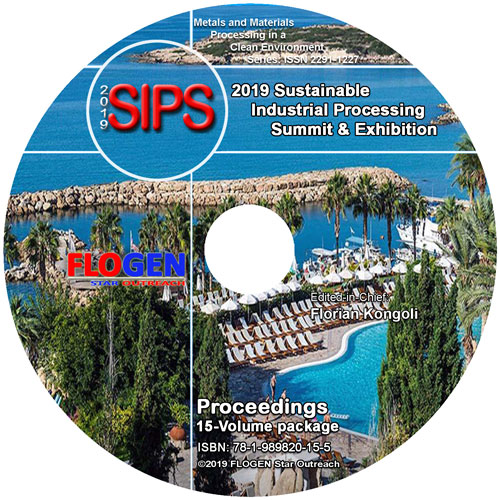2019-Sustainable Industrial Processing Summit
SIPS2019 Volume 8: Usui Intl. Symp. / Advanced Sustainable Iron and Steel Making
| Editors: | F. Kongoli, P. Assis, M.C. Gomez-Marroquin, S. Kitayama, H. Konishi, A. Murao, S. Nomura, H. Ono, H. Saxen, K. Seto, J.I. Tani |
| Publisher: | Flogen Star OUTREACH |
| Publication Year: | 2019 |
| Pages: | 250 pages |
| ISBN: | 978-1-989820-07-0 |
| ISSN: | 2291-1227 (Metals and Materials Processing in a Clean Environment Series) |

CD shopping page
Effect of Iron Ore-Carbon Composite Structure on Phosphorus Content in Reduced Molten Iron and Slag
Taichi Murakami1; Daisuke Maruoka2; Eiki Kasai1;1GRADUATE SCHOOL OF ENVIRONMENTAL STUDIES, TOHOKU UNIVERSITY, Sendai, Japan; 2TOHOKU UNIVERSITY, Sendai, Japan;
Type of Paper: Invited
Id Paper: 76
Topic: 2
Abstract:
Demand for utilizing iron ore with high phosphorus content is increasing because of the depletion of the resource for high-grade iron ore. Utilization of oolitic hematite with very high phosphorus content [1] and development of the dephosphorization method by reduction and melting of iron ore-carbon composite are the main focus of this paper. It is known that most of phosphorus exists as calcium phosphate in oolitic hematite. It is known that calcium phosphate can reduce to phosphorus gas and moves into metallic iron in iron ore-carbon composites. In this study, the effect of the iron ore layout in composite on dephosphorization behavior is evaluated.
Four thin composite samples, using hematite reagent, coke and three compacts of oolitic hematite, were prepared. These samples (thickness=2mm) were then set in the alumina crucible, which is named as the layer sample. The mixing ratio of total carbon to oxygen in iron oxide was 0.8 in molar [2]. For comparison, a uniform mixing composite sample was prepared using oolitic reagent, hematite powders (Ore: Reagent = 2:1) and coke. The sample was heated up to different target temperatures at a heating rate of 0.167°C/s. Phosphorus content in oolitic hematite, reduced iron, and slag was measured by ICP-AES. Phosphorus content in oolitic hematite was 0.78%. After heating up to 1300°C, melted iron and slag were obtained, and phosphorus content in melted iron of the layer sample was estimated at approximately 0.04% while that of the uniform mixing composite was approximately 0.4%.
Keywords:
CO2; Iron; Melting; Slag;References:
[1] M.Omran, T.Fabritius, R.Mattila, Powder Technology, 269(2015), 7-14.[2] T.Murakami, T.Nishimura, E.Kasai, ISIJ International, 49(2009), 1686-1693.